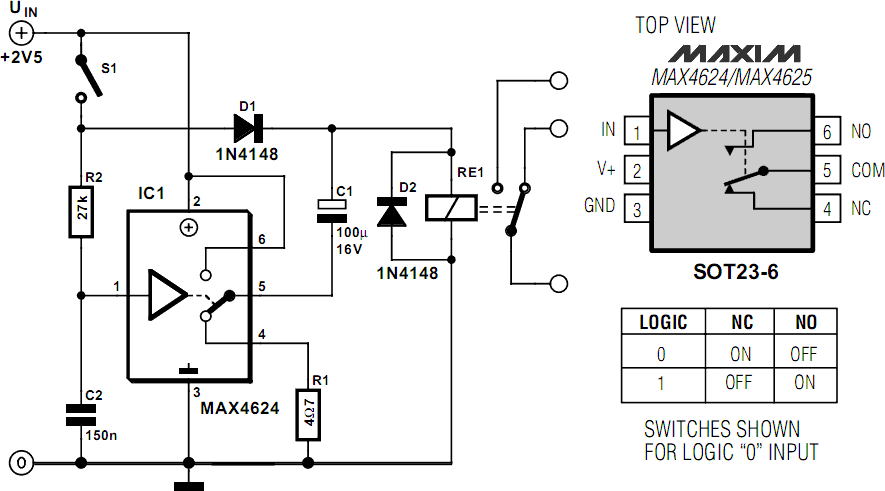
motor-control-microcontrollers-miscellaneous

If an application utilizes a MOSFET to switch a load, it is straightforward to incorporate short-circuit or overload protection. This can be achieved by leveraging the internal resistance RDS(ON), which generates a voltage drop proportional to the current flowing through the MOSFET. The voltage across this internal resistance can be sensed using a simple comparator or a transistor that activates at approximately 0.5V. This approach eliminates the need for a sense resistor (shunt), which typically introduces an undesirable additional voltage drop. The comparator output can be monitored by a microcontroller, allowing the software to implement appropriate countermeasures in the event of an overload, such as PWM regulation, alarms, or emergency stops. It is also possible to connect the comparator output directly to the gate of the MOSFET to immediately disable the transistor in the event of a short circuit.
In this circuit design, the MOSFET acts as the primary switching element for the load. The internal resistance RDS(ON) plays a critical role in monitoring the current through the MOSFET. As the current increases, the voltage drop across RDS(ON) increases, which can be monitored to detect overload conditions. A comparator is employed to compare this voltage drop against a reference voltage of approximately 0.5V. When the voltage exceeds this threshold, the comparator output changes state, indicating an overload condition.
The microcontroller is programmed to respond to the comparator's output. In normal operation, the software continuously checks the comparator status. Upon detecting an overload, the microcontroller can execute various protective actions, such as reducing the duty cycle of a PWM signal to limit current, triggering an alarm to alert the user, or initiating an emergency stop sequence to protect the circuit and the load.
For enhanced responsiveness, the comparator output can be directly linked to the gate of the MOSFET. This configuration allows for immediate shutdown of the MOSFET in the event of a short circuit, providing an additional layer of protection. The design eliminates the need for external sense resistors, which can introduce additional power losses and complicate the circuit layout.
Overall, this method of utilizing the internal characteristics of the MOSFET for current sensing and incorporating a comparator for overload detection creates a compact and efficient solution for protecting electronic circuits against overload and short-circuit conditions.If you have an application in which a MOSFET is already used to switch a load, it is relatively easy to add short-circuit or overload protection. Here we make use of the internal resistance RDS(ON), which produces a voltage drop that depends on the amount of current flowing through the MOSFET.
The voltage across the internal resistance can be sens ed using simple comparator or even a transistor, which switches on at a voltage of around 0. 5V. You can thus avoid the use of a sense resistor (shunt), which usually produces an undesirable extra voltage drop. The comparator can be monitored by a microcontroller. In case of an overload, the software can initiate suitable countermeasures (PWM regulation, alarm, emergency stop etc.
). It is also conceivable to connect the comparator output directly to the gate of the MOSFET, in order to immediately cut off the transistor in case of a short circuit. 🔗 External reference
In this circuit design, the MOSFET acts as the primary switching element for the load. The internal resistance RDS(ON) plays a critical role in monitoring the current through the MOSFET. As the current increases, the voltage drop across RDS(ON) increases, which can be monitored to detect overload conditions. A comparator is employed to compare this voltage drop against a reference voltage of approximately 0.5V. When the voltage exceeds this threshold, the comparator output changes state, indicating an overload condition.
The microcontroller is programmed to respond to the comparator's output. In normal operation, the software continuously checks the comparator status. Upon detecting an overload, the microcontroller can execute various protective actions, such as reducing the duty cycle of a PWM signal to limit current, triggering an alarm to alert the user, or initiating an emergency stop sequence to protect the circuit and the load.
For enhanced responsiveness, the comparator output can be directly linked to the gate of the MOSFET. This configuration allows for immediate shutdown of the MOSFET in the event of a short circuit, providing an additional layer of protection. The design eliminates the need for external sense resistors, which can introduce additional power losses and complicate the circuit layout.
Overall, this method of utilizing the internal characteristics of the MOSFET for current sensing and incorporating a comparator for overload detection creates a compact and efficient solution for protecting electronic circuits against overload and short-circuit conditions.If you have an application in which a MOSFET is already used to switch a load, it is relatively easy to add short-circuit or overload protection. Here we make use of the internal resistance RDS(ON), which produces a voltage drop that depends on the amount of current flowing through the MOSFET.
The voltage across the internal resistance can be sens ed using simple comparator or even a transistor, which switches on at a voltage of around 0. 5V. You can thus avoid the use of a sense resistor (shunt), which usually produces an undesirable extra voltage drop. The comparator can be monitored by a microcontroller. In case of an overload, the software can initiate suitable countermeasures (PWM regulation, alarm, emergency stop etc.
). It is also conceivable to connect the comparator output directly to the gate of the MOSFET, in order to immediately cut off the transistor in case of a short circuit. 🔗 External reference